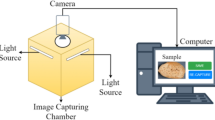Abstract
Convolutional neural networks (CNNs) play a significant role in a number of computer vision applications like image classification and object detection. Past studies have focused on the application of deep neural networks and convolutional neural networks for detecting the freshness of perishable goods like fruits and vegetables. However, this study tries to explore the potential of transfer learning with respect to the CNN models in image classification of fruits rather than implementing the traditional CNN architectures. In this study, the determination of three different types of fruits and its relative freshness was classified using various architectures of classical convolutional neural networks and a residual convolutional neural network. The performance of each model of the convolutional neural network was evaluated on the given set of data. The study tried to evaluate the best performing model on image data that consisted of six different types of fruits based on their test scores. The results suggest that the freshness of fruits could be determined with high accuracy by using traditional and residual convolutional neural networks. However, the residual networks perform extremely well on the fruits dataset which was considered with a test accuracy score greater than 99%. A glimpse on the implementation of the given algorithm in the food industry was also explored. Thus, this study attempts to select the CNN model that could be applied in the food industry in complementation with other computer vision techniques like background reduction, image augmentation methods.




Similar content being viewed by others
References
Ananthi N et al (2019) An image processing based fungus detection system for mangoes. Int J Innov Technol Explor Eng (IJITEE)
Aniket H et al (2020) Fruit freshness detection using CNN approach. Int Res J Modern Eng Technol Sci
Ann N (2019) Automatic classification for fruits’ types and identification of rotten ones using k-NN and SVM. Int J Online Biomed Eng (iJOE)
Anuja B, Bhansal A (2018) Fruits and vegetables quality evaluation using computer vision: a review. J King Saud Univ - Comp Inform Sci
Ayman E (2012) Understanding color image processing by machine vision for biological materials. IntechOpen
Bennedsen BS, Peterson DL (2005) Identifying defects in images of rotating apples. Comput Electron Agric
Dameshwari S, Ravindra P (2017) Defect identification and maturity detection of mango fruits using image analysis. Am J Artif Intell
Dariush A, Azam B (2021) An objective method to evaluate exemplar-based inpainted images quality using Jaccard index. Multimedia Tools Appl
Dariush A, Azam B, “Inpainted image quality evaluation based on saliency map features”, 5th Iranian conference on signal processing and intelligent systems (ICSPIS), 2019.
David I et al (2019) A computer vision system for defect discrimination and grading in tomatoes using machine learning and image processing. Artif Intell Agric
Dayanand S (2012) Identification and classification of bulk fruits images using artificial neural networks. Int J Eng Innov Technol (IJEIT)
Guoxiang Z (2017) Fruit and vegetables classification system using image saliency and convolutional neural network. IEEE
Hameed K et al (2018) A comprehensive review of fruit and vegetable classification techniques. Image and Vision Computing
He K et al (2012) Deep residual learning for image recognition, arXiv
Horea M, Mihai O (2018) Fruit recognition from images using deep learning. Acta Universitatis Sapientiae, Informatica
Kalluri SR (2018) Fruits fresh and rotten for classification (version 1) [data set]. Zenodo https://doi.org/10.5281/ZENODO.4788774
Ke S et al (2016) Recognition of Mould Colony on Unhulled Paddy based on computer vision using conventional machine-learning and deep learning techniques. Scientific Reports
Koyama K et al (2021) Predicting sensory evaluation of spinach freshness using machine learning model and digital images. PLoS One
Krizhevsky A et al (2012) ImageNet classification with deep convolutional neural networks.
Wang Lu, et al., “Detection of fruit skin defects using machine vision system”, IEEE, 2014.
Mahmoud H et al (2018) A study on CNN transfer learning for image classification. Adv Comput Intell Syst
Modhej N et al (2020) Pattern separation network based on the hippocampus activity for handwritten recognition. IEEE
Naoshi K (2010) Automation on fruit and vegetable grading system and food traceability. Trends Food Sci Technol
Ray Z et al (2017) Food supply chain management: systems, implementations, and future research. Industrial Manag Data Syst
Santi B et al (2020) Identification, classification & grading of fruits using machine learning & computer intelligence: a review. J Ambient Intell Human Comput
Shiv D, Anand J, “Apple disease classification using color, texture and shape features from images”, Signal, Image and Video Processing, 2016.
Simonyan K, Zisserman A (2015) Very deep convolutional networks for large-scale image recognition. ICLR
Singham P et al (2015) Importance of objective and subjective measurement of food quality and their inter-relationship. Food Process Technol
Author information
Authors and Affiliations
Corresponding author
Additional information
Publisher’s note
Springer Nature remains neutral with regard to jurisdictional claims in published maps and institutional affiliations.
Rights and permissions
About this article
Cite this article
Kazi, A., Panda, S.P. Determining the freshness of fruits in the food industry by image classification using transfer learning. Multimed Tools Appl 81, 7611–7624 (2022). https://doi.org/10.1007/s11042-022-12150-5
Received:
Revised:
Accepted:
Published:
Issue Date:
DOI: https://doi.org/10.1007/s11042-022-12150-5




